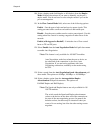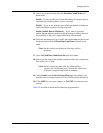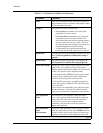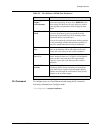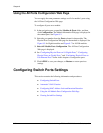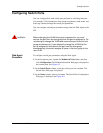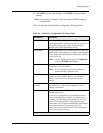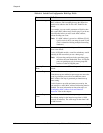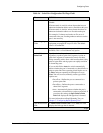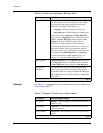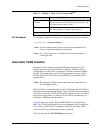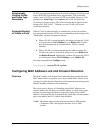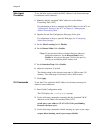
Document No. 10-300077, Issue 2 8-31
Configuring Ports
5. Click APPLY to save your changes, or CANCEL to restore default
settings.
* Note: Do not enable Automatic VLAN Creation and VTP Snooping at
the same time.
Table 8-6 describes the Switch Port Configuration Web page fields.
Table 8-6. Switch Port Configuration Web Page Fields
Parameter Definition
Port VLAN Specifies the VLAN assignment for this port.
All untagged frames arriving on this port are assigned to
this VLAN. The port still assigns incoming tagged
packets to the VLAN indicated by the tag.
Trunk Mode Select the appropriate VLAN trunking format to make the
port a trunk, or Clear (default) if you do not want the port
to be a trunk. The trunk formats are IEEE 802.1Q, Multi-
Layer, and 3Com.
Note: The 10-Gigabit module supports a Trunk Mode
setting of IEEE802.1 Q or Clear.
Frame Tags Select Ignore if you do not want to use received Frame
VLAN tags. Use is the default.
Note: If you select ignore, the received frames are
bound to the port’s default VLAN.
VLAN Binding Select the port’s outgoing VLAN binding type. The
options are Static (default), Bind-to-All, and Bind-to-
Receive. See Table 8-8 for an explanation of these
options.
Automatic VLAN
Creation
Select Enable to automatically create a VLAN each time
the port receives a frame from an unknown VLAN.
Disable is the default.
VTP Snooping Select Enable to allow VTP Snooping on this port.
Disable is the default.
VTP is a Cisco proprietary Layer 2 trunk port protocol
that is used among Cisco switches, over trunk ports, to
maintain a VLAN configuration consistency across the
network.The switch performs VTP operations when
connected to a Cisco switch’s trunk that has VTP enabled.
The switch queries its Cisco peer for its VLAN
configuration. It also learns Cisco VLAN configurations
from received Cisco message.
1 of 4




